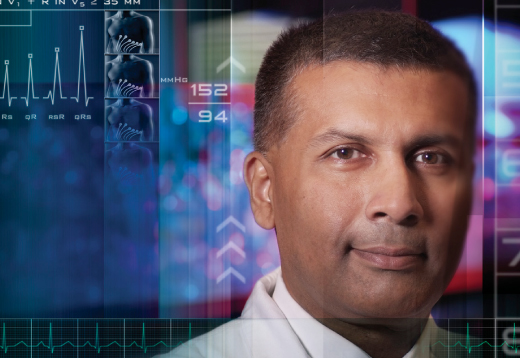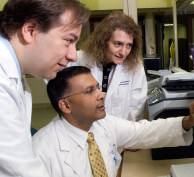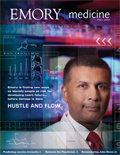Hustle and flow

Javed Butler's Health ABC Heart Failure Model is the first all-in-one system to predict an individual's risk of developing heart failure.
By Valerie Gregg | Illustration by Ralph KelliherHeart failure can be a final cause of death when the body's central engine runs out of steam, weakens, and finally stops pumping. Those living with heart failure can live with it for decades, although they may end up completely disabled for years. This chronic, progressive disease syndrome gobbles up a person's energy and breath, leaving them gasping, thirsty, and swollen with water retention. When a simple trip from bed to bathroom becomes a walk across a desert, their only hope may be a heart transplant.
Javed Butler, director of heart failure research at Emory, hopes to make that scenario an oddball outlier.
"We have gotten better at keeping patients with heart failure alive longer," he says. "Mortality has consistently gone down, although prevalence is increasing. But in terms of quality of life, when a person spends years hardly able to walk across the room, that is not a successful outcome.
 |
"Now we are working on models for effective interventions for intermediate- and high-risk patients. We're also stepping back to learn how to prevent heart failure, which is a dire need." —Javed Butler, director of heart failure research at Emory |
|||
Indeed, heart failure now afflicts nearly 5.7 million adults in the United States. Incidence is rising steadily with about 670,000 new cases reported every year.
Because heart failure is a syndrome that springs from a mishmash of different causes, a cure is not easy to come by. Simply keeping symptoms under control is the aim of most treatment plans. Prescription beta blockers keep blood pressure under control, a low-sodium diet prevents water retention and lung congestion, and exercise maintains the heart's strength.
To truly lessen the burden of heart disease, says Butler, prevention and early intervention are key. Finding new ways to identify people at risk for developing heart failure—before damage is done—is his raison d'etre and primary research focus.
Along with his colleagues, Butler recently created a statistical model, called the Health ABC Heart Failure Model, based on patient data to identify those at risk heart failure despite its elusive and wide-ranging causes.
Study results affirming wide-ranging aspects of the model are currently published or in press in Circulation, Cardiology, Archives of Internal Medicine, and other peer-reviewed scientific publications.
The ABC model uses nine measures to estimate heart failure risk, including age, history of heart disease, smoking, blood pressure, heart rate, left ventricular hypertrophy measured by electrocardiography, and blood levels of glucose, creatinine, and albumin. Butler says this model is the first to combine heart failure risk factors into a system to predict individual risk.
"Now we are working on models for effective interventions for intermediate- and high-risk patients," he says. "We're stepping back to learn how to prevent heart failure, which is a dire need."
Pinning down the roots
Diabetes, obesity, heart valve problems, lung disease, heart attack, and irregular heartbeats are only some factors that can cause heart failure. "Pinning down the roots of heart failure can be confusing," says Butler. "Unlike some heart problems, heart failure is not one disease. It has a few common causes, and a few less common, even rare, causes.
Heart failure occurs when the heart muscle loses pumping strength and no longer supplies enough oxygenated blood to the rest of the body. The body responds to a weak heart the same way it would to a low blood volume from dehydration or bleeding. When there is too little to go around, blood diverts from peripheral vessels and arteries to sustain the heart and brain. Arteries and blood vessels throughout the body eventually narrow to keep blood pressure up.
Those with heart failure feel exhausted and short of breath. Their kidneys hold onto salt, making them constantly thirsty. They crave salt and fluid, which leaves them more congested, creating a vicious cycle. Over time, every organ system in the body suffers, including the heart itself.
Addressing underlying causes
No one lives forever, but keeping heart disease risk factors at bay can help people make the most of their later years, says Butler.
"Without diabetes, obesity, smoking, or high blood pressure by the age of 50, a person is very unlikely to have clinical symptoms from heart disease for the rest of their lives," says Butler, who is deputy chief science officer for the American Heart Association. "But obesity and diabetes epidemics continue to worsen, contributing to even more heart failure. Also people are treated for heart attack survive longer now but in turn live with a weaker heart. We need to focus on prevention and treatment in a comprehensive way.
In the past, he says, heart failure specialists "let the proverbial elephant get by while focusing solely on treating the resulting heart disease." Because heart failure is a complex chronic disease, prevention and successful treatment are related to psychosocial factors such as patients' literacy level, their comprehension of their treatment regimen, and their level of social support.
"We need to collect data for a variety of different players on the health care team," he says. "Surgeons, nurses, and social workers all look at heart failure from a different angle."
Butler has developed an infrastructure for a comprehensive cohort study of patients with heart failure. Researchers already have begun collecting comprehensive baseline data on patients at Emory hospitals and at Grady Hospital. Patients in the study return to the clinic every six months for follow-up.
"We have a dozen cross-disciplinary investigators on board to develop this cohort on one platform," he says. "Our questionnaires ask patients about their family histories and dynamics. Nursing is particularly interested in personal, cultural, and religious factors. We have a biobank to collect patients' blood, urine, and genetic markers. We read their echocardiograms extremely closely.
"The idea behind this study is not just to answer my own questions about heart failure, but also to answer those of nurses, pathologists, geneticists, cardiothoracic surgeons, and cardiologists."
Butler's team is collaborating with the CDC and the Cleveland Clinic to run blood and tissue samples through their labs. Finding funding to carry out the entire project, which will go on for several years, is in the works.
"We are preparing to do research that nobody has done before that we hope will make life better for many, many people," he says. EM
Keeping tabs on heart patients from afarThe number of heart failure patients at Emory University Hospital (EUH) and EUH Midtown has ballooned considerably over the past 10 years, and physicians have found new and innovative ways to take care of their patients, says Andrew Smith, Emory's medical director of heart failure and transplantation for Emory Healthcare. One such tool is telemonitoring, which allows physicians to gather more data and provide better care while minimizing inconvenience to patients. "About 85% of heart failure patients admitted to the hospital have salt and water retention," says Smith. "Remotely monitoring our patients' symptoms helps reduce hospitalizations and extends clinic visits into the home." A telemonitoring system using a cell phone can send the clinic a patient's weight every time they step on a scale. Using another automated phone system, patients can call a central number every day, enter their weight, and answer a list of yes-or-no questions. A nurse practitioner reviews their answers daily. If a patient gains more than 4 pounds in one day or if their symptoms indicate a problem, they are called to come in to the clinic. Surgically implanted pacemaker defibrillators help patients whose heart failure is complicated by heart arrhythmias. Sensor technology detects abnormal heartbeats, and the defibrillators pace or shock the heart back into rhythm. "One company has Bluetooth technology," Smith says. "If the patient steps on a scale, the information goes to the defibrillator. At night the information is logged onto a central computer system. We can track it and see if there's a weight increase over a few days." Another remote device can measure electrical signals across the lung, which measures fluid retention. Smith is eagerly anticipating the completion of clinical trials now under way at EUH and EUH Midtown for several investigational telemonitoring devices. "One experimental device called Cardiomems is a sensor implantable in the pulmonary artery," he says. "The pressure in the pulmonary artery goes up when heart failure is worsening. Cardiomems transmits important information to us early enough so we can get the blood pressure under control before too much damage is done and the patient needs to be hospitalized." Keeping heart failure patients healthy is Smith's ultimate aim. |
||


